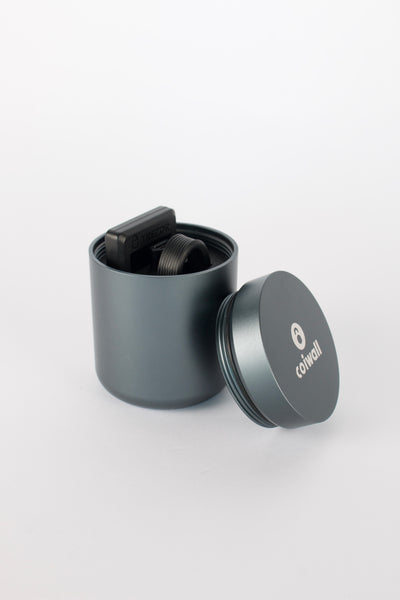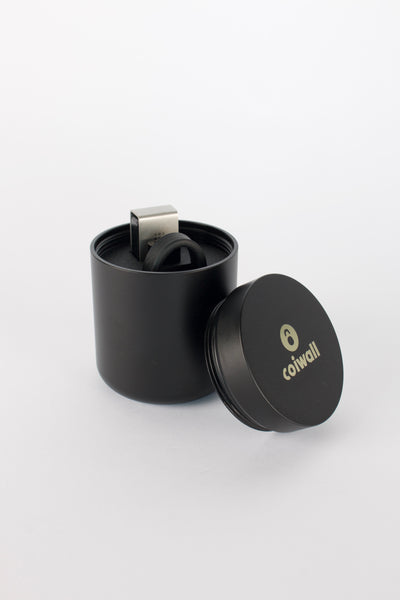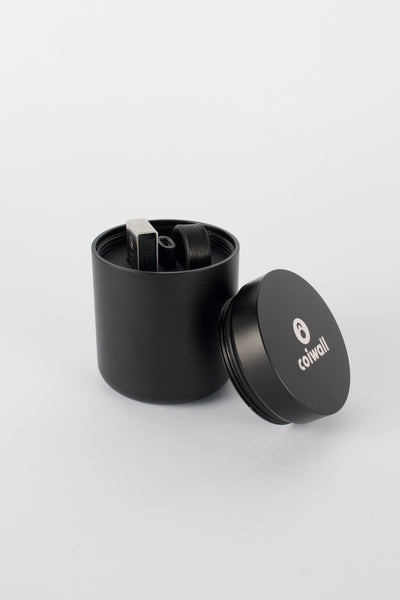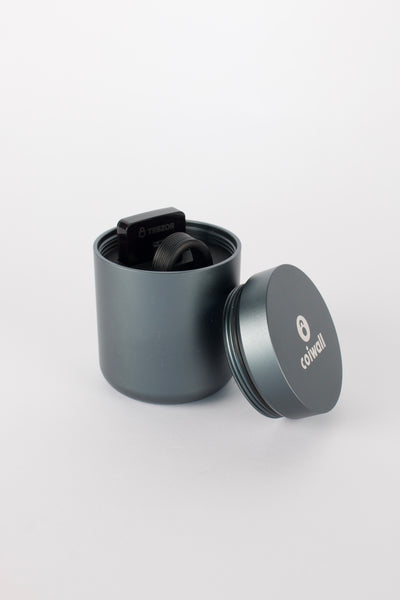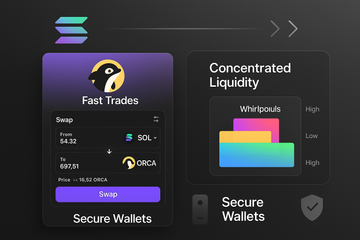If you have ever tapped a swap on Solana and felt the trade confirm before you could blink, you probably touched Orca. It is a decentralized exchange that tries to keep things human. Simple screens. Clear prices. Quick finality. You know what? That mix draws both casual traders and folks who live in liquidity positions.
Let me explain what makes Orca tick, how Whirlpools work in plain language, and how to keep your funds safe while you explore those pools.
What is Orca, really?
Orca is a decentralized exchange, or DEX, built on the Solana blockchain. It uses an automated market maker model, so trades happen against pools of tokens rather than through a traditional order book. That structure lowers friction and often lowers slippage. Because it runs on Solana, you get near-instant settlement and low transaction fees. That part is not hype, it shows up in daily use.
The interface is part of the charm. Orca prioritizes a clean swap flow, a clear price readout, and a fair price indicator that checks the quoted price against outside market data. If the quote is off by too much, you will see it. It is like having a friend whisper, hey, that looks pricey.
Whirlpools, explained without the math headache
Orca’s concentrated liquidity feature is called Whirlpools. In plain terms, you choose a price range where your liquidity is active, not the entire spectrum. Your funds then work harder inside that range. When trades happen within it, you earn a larger share of fees compared to a traditional, spread-out pool.
There is a catch, and it is a fair one. If the market moves outside your chosen range, your position stops earning fees until the price returns. So the strategy feels a bit like setting a fishing net where the fish are now, not everywhere all at once. You gain efficiency, but you also accept the need to adjust ranges now and then.
Fee tiers vary by pool. Common tiers include low, medium, and high settings that reflect how volatile or stable a pair tends to be. Stable pairs often use very low fees. Spicier pairs use higher fees, since swings are common and traders accept that cost.
Trading on Orca, step by step
The trade flow is straightforward:
- Connect a wallet. Phantom and Solflare are popular on Solana. Ledger hardware wallets can connect through these wallets for extra security.
- Select your pair. The token list is broad, covering blue chips and new projects alike.
- Check the quote. Orca’s fair price indicator helps keep you grounded. Slippage settings are easy to tweak if a market is moving fast.
- Confirm and settle. Solana’s speed makes the last step feel smooth. You see it, then it is done.
That is it. No drama, just swaps.
Where fees and rewards come from
On Orca, liquidity providers earn the trading fees paid by swappers. In Whirlpools, your share depends on your liquidity amount and whether the current price sits inside your chosen range. Some pools also run partner incentives. These are time-limited rewards paid in the project’s token. When incentives are live, the APR can jump, which looks great on paper.
Here is the thing. APR snapshots change. They ebb and flow with volume, price, and incentive schedules. Treat the number as a pointer, not a promise. That mindset helps you stay calm during the noisy parts of a market cycle.
Wallets, hardware, and staying safe
Security talk is not flashy, but it is worth your time. If you are planning to LP with size or just want peace of mind, consider a hardware wallet.
- Ledger. Ledger Nano devices work with Solana through wallets like Phantom and Solflare. You connect your Ledger, approve transactions on the device, and keep your keys offline. Trading on Orca via Phantom or Solflare while signing with Ledger is a common setup.
- Trezor. Trezor support for Solana has been limited across apps, and it changes over time. Some third-party wallets and bridges have explored it. If you use Trezor, check the latest compatibility notes from your wallet provider before you connect to a Solana dApp like Orca.
Two extra tips that save headaches. First, verify URLs, then bookmark Orca’s official site; fake links move fast. Second, review token approvals and connected apps in your wallet every so often. It feels boring. It also works.
Impermanent loss, the quiet risk you should understand
If you provide liquidity, you face impermanent loss. The phrase sounds harsh, but the concept is simple. When prices move a lot, the pool rebalances your tokens. You can end up with more of the token that fell and less of the one that rose. Compared to holding both tokens in your wallet, your net value may be lower when you withdraw.
Does that mean LPing is bad? Not at all. Fee income can offset that loss, especially in pools with steady volume. Concentrated liquidity can help too, because your capital earns more when trades hit your range. It is a tradeoff. You accept price risk to earn fees. You manage the range to tilt the odds.
How Orca fits in the Solana toolbelt
Solana’s DeFi scene moves quickly. Traders often use aggregators like Jupiter for route finding, then settle on Orca pools when the route points there. Wallets add to the flow with quick-quote screens and simple gas controls. It is a small detail, but it matters for daily use. You get choice without getting lost.
Orca also plays well with dashboards. Sites like DeFiLlama and similar trackers show pool TVL and volume trends. If you are comparing pools, open a chart, watch volume, and then pick a fee tier that matches the pair’s personality. A chill stable pair and a whippy meme pair do not belong in the same fee bucket.
Governance and the ORCA token
Orca has a governance token called ORCA. Holders can guide parts of the protocol’s direction, like incentives or pool parameters. It is not a magic wand, but it gives the community a voice. If you care about the roadmap, voting and proposals are where you lean in.
Little details that feel big in practice
- Fair price checks. Orca’s pricing screen helps spot off-market quotes. It is a small guardrail that prevents rushed mistakes.
- Clear position tools. Creating a Whirlpool position shows your min and max price, expected fee tier, and estimated APR if incentives exist. The layout cuts jargon without dumbing it down.
- Low friction for small trades. Solana’s fees are tiny, so test trades make sense. Send a small swap first, then size up once you see it settle.
A quick, realistic playbook for LPs
Start simple
Pick a pair you understand, ideally one you would hold anyway. Keep the first range fairly wide to reduce the chance of going out of range on day one. You can narrow it later if you want more fee density.
Match fee tier to volatility
Stablecoins and pegged assets often fit low fee tiers. Exotic pairs or new tokens may deserve higher tiers, since the price can jump. This is not foolproof, but it keeps your settings aligned with how the pair behaves.
Use alerts and check-ins
Set price alerts on your wallet or a market app. When price approaches your range edge, you can adjust. Not every move needs action. Still, a quick look beats a surprise.
Mind your taxes and tracking
LP positions create lots of small events. If your region treats them as taxable, a tracker like CoinTracker or Koinly can help untangle the flow. It is not thrilling, but future you will be grateful.
Common pitfalls, and how to dodge them
- Chasing APR on unknown tokens. High numbers tempt everyone. If the token has thin liquidity or weak demand, fees and incentives may not cover price drawdowns.
- Setting ultra-narrow ranges on day one. It feels efficient, until you wake up out of range. Start wider. Learn the rhythm of the pair. Then tighten if it fits your style.
- Ignoring wallet hygiene. Hardware signers, fresh approvals, and verified URLs cut most attack surfaces. Security is a habit, not a gadget.
So, why Orca?
Orca lives at a nice intersection. It is friendly enough for a first swap. It is deep enough for a serious LP strategy. The UI respects your time, the pricing tools keep you honest, and the network’s speed makes it feel smooth even on a noisy day.
Honestly, that balance is rare. Many DEXs either bury you in toggles or treat you like you need none. Orca tries for a middle path, and most days, it lands close.
Final thoughts
If you are exploring Solana DeFi, give Orca a look. Swap something small. Try a beginner Whirlpool range with a pair you know. Connect your Ledger if you have one, or double-check your wallet security before you size up. Keep notes on what works for you, not just what looks good on a dashboard.
Markets shift, incentives rotate, and fees ebb and flow. What stays steady is a clean interface, quick settlement, and a set of tools that respect both newcomers and pros. That is Orca’s pitch, and for many, it is enough.

